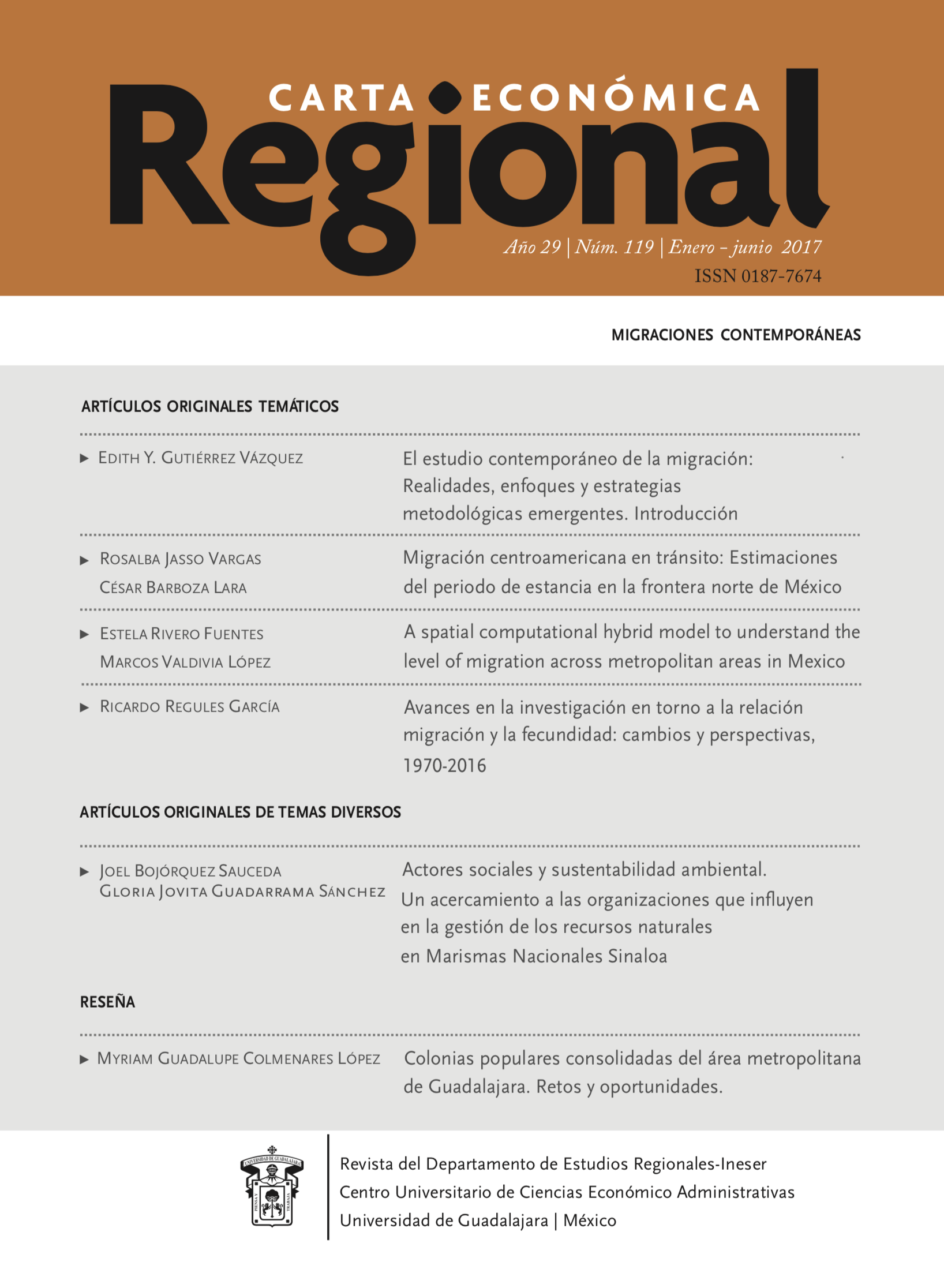Avances en la investigación en torno a la relación entre migración y fecundidad: cambios y perspectivas, 1970-2016
Resumen
La pregunta central que guía esta revisión de literatura es ¿cómo se ha abordado en la investigación sociodemográfica la relación entre migración y fecundidad? En este trabajo, además de discutir algunos de los hallazgos en torno a ella, se hace un recuento de los niveles de análisis enfatizados, las fuentes de información utilizadas y los cambios ocurridos en la medición del fenómeno en el periodo 1970-2016. También se discuten los alcances y las limitaciones de las perspectivas teóricas a partir de las cuales se han explicado los niveles y las tendencias de la fecundidad de la población migrante, tanto en los lugares de origen como en los de destino. Con base en lo anterior, también se identifican rutas para investigaciones futuras que contribuyan a mejorar nuestra comprensión del comportamiento reproductivo de las personas migrantes.Citas
Adserá, A. & Ferrer, A. (2016). The fertility of married immigrant women to Canada. International Migration Review, 50, 475-505.
Amaro, H. (1988). Women in the Mexican-American community: religion, culture, and reproductive attitudes and experiences. Journal of Community Psychology, 16, 6-20.
Andersson, G. (2004). Childbearing after migration: fertility patterns of foreign-born women in Sweden. International Migration Review, 38, 747-774.
Bach, R. L. (1981). Migration and fertility in Malaysia: a tale of two hypotheses. International Migration Review, 15, 502-521.
Bankole, A. & Singh, S. (1998). La decisión de la pareja en cuestiones de fecundidad y anticoncepción en los países en desarrollo: escuchar la opinión del hombre. Perspectivas Internacionales en Planificación Familiar, núm. especial, 18-37.
Bankole, A. & Westoff, C. F. (1998). Childbearing attitudes and intentions. dhs Comparative Studies No. 17, Calverton, Macro International Inc.
Bhugra, D. (2003). Migration and depression. Acta Psychiatrica Scandinavica, 108, 77-82.
Bledsoe, C.H. (20049. Reproduction at the margins: Migration and legitimacy in the new Europe. Demographic Research, special collection 3, 87-116.
Bongaarts, J. (1992). Do reproductive intentions matter? International Family Planning Perspectives, 18, 102-108.
Bongaarts, J. & Potter, R. G. (1979). Fertility effect of seasonal migration and seasonal variation in fecundability: test of a useful approximation under more general conditions. Demography, 16, 475-479.
Brambila Paz, C. (1985). Migración y formación familiar en México. México: El Colegio de México.
Canales, A. I. (2015). El papel de la migración en el sistema global de reproducción demográfica. Notas de Población, 100, 91-123.
Carlson, E. D. (1985). The impact of international migration upon the timing of marriage and childbearing. Demography, 22, 61-72.
Castro Martín, T. & Roseo-Bixby, L. (2011). Maternidades y fronteras. La fecundidad de las mujeres inmigrantes en España. Revista Internacional de Sociología, 1, 105-137.
Chattopadhyay, A., White, M. J. & Depbuur, C. (2006). Migrant fertility in Ghana: selection versus adaptation and disruption as causal mechanisms. Population Studies, 60, 189-203.
Dorn, H. F. & Lorimer, F. (1936). Migration, reproduction, and population adjustment. The Annals of the American Academy of Political and Social Science, 188, 280-289.
Farber, S. C. & Lee, B.S. (1984). Fertility adaptation of rural-to-urban migrant women: a method of estimation applied to Korean women. Demography, 21, 339-345.
Ford, K. (1990). Duration of residence in the United States and the fertility of U.S. immigrants. International Migration Review, 24, 34-68.
Frank, R. & Heuveline, P. (2005). A crossover in Mexican and Mexican-American fertility rates: evidence and explanations for an emerging paradox. Demographic Research, 12, 77-104.
Goldstein, S. (1973). Interrelations between migration and fertility in Thailand. Demography, 10, 225-241.
Goldstein, S. & Goldstein, A. (1981). The impact of migration on fertility: an ‘own children’ analysis for Thailand. Population Studies, 35, 265-284.
Goldstein, S. & Goldstein, A. (1983). Migration and fertility in peninsular Malaysia: an analysis using life history data. The Agency for International Development.
Gyimah, S. O. (2006). Migration and fertility behavior in Sub-Saharan Africa: the case of Ghana. Journal of Comparative Family Studies, 22, 235-252.
Hervitz, H. M. (1985). Selectivity, adaptation, or disruption? A comparison of alternative on the effects of migration on fertility: the case of Brazil. International Migration Review, 19, 293-317.
Jensen, E. & Ahlburg, D. A. (2004). Why does migration decrease fertility? Evidence from the Philippines. Population Studies, 58, 219-231.
Juárez, F. (1996). La formación de la familia y la movilidad a las áreas metropolitanas en México: un nuevo enfoque de la interacción entre eventos demográficos. En Juárez, F., Quilodrán, J. & Zavala de Cosío, M. E. (eds.), Nuevas pautas reproductivas en México (pp. 147-198). México: El Colegio de México.
Kahn , J. R. (1988). Immigrant selectivity and fertility adaptation in the United States. Social Forces, 67, 108-128.
Kahn , J. R. (1994). Immigrant and native fertility during the 1980s: adaptation and expectations for the future. International Migration Review, 28, 501-519.
Kiser, C. V. (1938). Birth rates among rural migrants in cities. The Milbank Memorial Fund Quarterly, 16, 369-381.
Kulu, H. (2003). Migration and fertility: competing hypotheses re-examined. Max-Planck-Institute for Demographic Research (mpidr) Working Paper WP 2003-035.
Kulu, H. (2006). Fertility of internal migrants: comparison between Austria and Poland. Population, Space and Place, 12, 147-170.
Kulu, H. & González Ferrer, A. (2014). Family dynamics among immigrants and their descendants in Europe: current research and opportunities. European Journal of Population, 30, 411-435.
Lee, B. S. (1992). The influence of rural-urban migration on migrant’s fertility behavior in Cameroon. International Migration Review, 26, 1416-1447.
Lee, B. S. & Farber, S. C. (1985). The influence of rapid rural-urban migration on Korean national fertility levels. Journal of Development Economics, 17, 47-71.
Lee, B. S. & Pol, L. G. (1993). The influence of rural-urban migration on migrant’s fertility in Korea, Mexico and Cameroon. Population Research and Policy Review, 12, 3-26.
Lerch, M. (2009). The impact of migration on fertility in post-communist Albania. Southeast European and Black Sea Studies, 9, 519-537.
Lindstrom, D. P. y Giorguli Saucedo, S. (2002). The short- and long-term effects of U.S. migration experience on Mexican women’s fertility. Social Forces, 80, 1341-1368.
Lindstrom, D. P. y Giorguli Saucedo, S. (2007). The interrrelationship between fertility, family maintenance, and Mexico-U.S. migration. Demographic Research, 17, 821-858.
Macisco, J. J., Bouvier, L. F. & Renzi, M. J. (1969). Migration status, education and fertility in Puerto Rico, 1960. The Milbank Memorial Quarterly, 47, 167-186.
Macisco, J. J. Bouvier, L. F. & y Weller, H. R. (1970). The effect of labor force participation on the relation between migration status and fertility in San Juan, Puerto Rico. The Milbank Memorial Quarterly, 48, 51-70.
Massey, D. S. & Mullan, B. P. (1984). A demonstration of the effect of seasonal migration on fertility. Demography, 21, 501-517.
Mayer, J. & Riphahn, R. T. (2000). Fertility assimilation of immigrants: evidence from count data models. Journal of Population Economics, 13, 241-261.
Menken, J. (1979). Seasonal migration and seasonal variation in fecundability: effects on birth rates and birth intervals. Demography, 16, 697-717.
Milewski, N. (2007). First child of immigrant workers and their descendants in West Germany: interrelation of events, disruption, or adaptation? Demographic Research, 17, 859-896.
Milewski, N. (2011). Transitions to a first birth among Turkish second-generation migrants in Western Europe. Advances in Life Course Research, 16, 178-189.
Monnier, A. (1989). Fertility intentions and actual behaviour. A longitudinal study: 1974, 1976, 1979. Population: An English Selection, 44 (1), 237-259.
Mussino, E. & Strozza, S. (2012). The fertility of immigrants after arrival: the Italian case. Demographic Research, 26, 99-130.
Nair, N. K. & Chow, L. P. (1980). Fertility intentions and behavior: some findings from Taiwan. Studies in Family Planning, 11, 255-263.
Ng, E. & Nault, F. (1997). Fertility among recent immigrant women to Canada, 1991: an examination of the disruption hypothesis. International Migration, 35, 559-570.
Palma Cabrera, Y. (2016). El embarazo adolescente en un contexto de alta inmigración. Notas de Población, 103, 9-27.
Parrado, E. A. (2011). How high is Hispanic/Mexican fertility in the United States? Immigration and tempo considerations. Demography, 48, 1059-1080.
Parrado, E. A. (2015). Migration and fertility. International Encyclopedia of the Social and Behavioral Science, 15, 397-406.
Parrado, E. A. & Morgan, P. (2008). Intergenerational fertility among Hispanic women: new evidence of immigrant assimilation. Demography, 45, 651-671.
Perlmann, J. & Waldinger, R. (1997). Second generation decline? Children of immigrants, past and present – A reconsideration. The International Migration Review, 3, 893-922.
Regules García, R. (2014). Sí quiero … y no puedo … Migración y el imaginario reproductivo. Tesis doctoral, México, El Colegio de México, Centro de Estudios Demográficos, Urbanos y Ambientales.
Rodriguez, G. & Hobcraft, J.N. Illustrative analysis: life table analysis of birth intervals in Colombia. World Fertility Survey Scientific Report, No. 16.
Rokicki, S, Montana, L. & Fink, G. (2014). Impact of migration on fertility and abortion: evidence from the household and welfare study of Accra. Demography, 51, 2229-2254.
Roy, T. K. Sinha, R. K., Koenig, M., Mohanty, S. K. & Patel, S. K. (2008). Consistency and predictive ability of fertility preference indicators: longitudinal evidence from rural India. International Family Planning Perspectives, 34, 138-145.
Silva De, W. I. (1991). Consistency between reproductive preferences and behavior: the Sri Lankan experience. Studies in Family Planning, 22, 188-197.
Singley, S. G. & Landale, N. S. (1998). Incorporating origin and process in migration-fertility frameworks: the case of Puerto Rican women. Social Forces, 76, 1437-1464.
Stephen, E. H. & Bean, F. D. (1992). Assimilation, disruption and the fertility of Mexican-origin women in the United States. International Migration Review, 26, 67-88.
Toulemon, L. (2004). La fecondité des immigrées: nouvelles données, nouvelle aproche. Population et Sociétés, 400.
Toulemon, L. & Mazuy, M. (2004). Comment prendre en comprte l’âge à l’arrivée et la durée de séjour en France dans la mesure de la fécondité des immigrants?. Documents de Travail 120. INED.
Weller, R. H. y Macisco, J. J. Jr. (1971). Fecundidad, migración y aspiraciones de movilidad social en los países en desarrollo: sugerencias para investigación. Demografía Económica, 1, 56-76.
White, K. & Buckley, C. J. (2011). Exposure to international migration and its effect on childbearing in Turkey. International Migration Review, 45, 123-147.
White, M. J., Moreno, L. & Guo, S. (1995). The interrelation of fertility and geographic mobility in Peru: a hazards model analysis. International Migration Review, 29, 492-514.
Zerden, M. L., Stuart, G. S., Verbiest, S., DeRosset, L. & Tang, J. (2013). Family planning intentions: a qualitative exploration of postpartum women of Mexican descent in North Carolina. Contraception, 88, 624-628.
Aquellos autores/as que tengan publicaciones con esta revista, aceptan los términos siguientes:
- Los autores/as conservarán sus derechos de autor y garantizarán a la revista el derecho de primera publicación de su obra, el cuál estará simultáneamente sujeto a la Licencia de reconocimiento de Creative Commons que permite a terceros compartir la obra siempre que se indique su autor y su primera publicación esta revista.
- Los autores/as podrán adoptar otros acuerdos de licencia no exclusiva de distribución de la versión de la obra publicada (p. ej.: depositarla en un archivo telemático institucional o publicarla en un volumen monográfico) siempre que se indique la publicación inicial en esta revista.
- Se permite y recomienda a los autores/as difundir su obra a través de Internet (p. ej.: en archivos telemáticos institucionales o en su página web) déspues de que su trabajo sea publicado, lo cual puede producir intercambios interesantes y aumentar las citas de la obra publicada. (Véase El efecto del acceso abierto).











